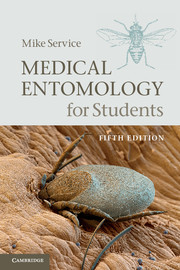Book contents
- Frontmatter
- Contents
- Preface to the first edition
- Preface to the second edition
- Preface to the third edition
- Preface to the fourth edition
- Preface to the fifth edition
- Acknowledgements
- 1 Introduction to mosquitoes (Culicidae)
- 2 Anopheline mosquitoes (Anophelinae)
- 3 Culicine mosquitoes (Culicinae)
- 4 Black flies (Simuliidae)
- 5 Phlebotomine sand flies (Phlebotominae)
- 6 Biting midges (Ceratopogonidae)
- 7 Horse flies (Tabanidae)
- 8 Tsetse flies (Glossinidae)
- 9 House flies and stable flies (Muscidae) and latrine flies (Fanniidae)
- 10 Flies and myiasis
- 11 Fleas (Siphonaptera)
- 12 Sucking lice (Anoplura)
- 13 Bedbugs (Cimicidae)
- 14 Triatomine bugs (Triatominae)
- 15 Cockroaches (Blattaria)
- 16 Soft ticks (Argasidae)
- 17 Hard ticks (Ixodidae)
- 18 Scabies mites (Sarcoptidae)
- 19 Scrub typhus mites (Trombiculidae)
- 20 Miscellaneous mites
- Appendix Names of some chemicals and microbials used in vector control (with common trade names in parentheses)
- Glossary of common terms relevant to medical entomology
- Select bibliography
- Index
- Plate section
- References
2 - Anopheline mosquitoes (Anophelinae)
Published online by Cambridge University Press: 05 June 2012
- Frontmatter
- Contents
- Preface to the first edition
- Preface to the second edition
- Preface to the third edition
- Preface to the fourth edition
- Preface to the fifth edition
- Acknowledgements
- 1 Introduction to mosquitoes (Culicidae)
- 2 Anopheline mosquitoes (Anophelinae)
- 3 Culicine mosquitoes (Culicinae)
- 4 Black flies (Simuliidae)
- 5 Phlebotomine sand flies (Phlebotominae)
- 6 Biting midges (Ceratopogonidae)
- 7 Horse flies (Tabanidae)
- 8 Tsetse flies (Glossinidae)
- 9 House flies and stable flies (Muscidae) and latrine flies (Fanniidae)
- 10 Flies and myiasis
- 11 Fleas (Siphonaptera)
- 12 Sucking lice (Anoplura)
- 13 Bedbugs (Cimicidae)
- 14 Triatomine bugs (Triatominae)
- 15 Cockroaches (Blattaria)
- 16 Soft ticks (Argasidae)
- 17 Hard ticks (Ixodidae)
- 18 Scabies mites (Sarcoptidae)
- 19 Scrub typhus mites (Trombiculidae)
- 20 Miscellaneous mites
- Appendix Names of some chemicals and microbials used in vector control (with common trade names in parentheses)
- Glossary of common terms relevant to medical entomology
- Select bibliography
- Index
- Plate section
- References
Summary
The subfamily Anophelinae contains three genera, but as explained in Chapter 1 only the genus Anopheles is of medical importance. Anopheles mosquitoes have an almost worldwide distribution, occurring in both tropical and temperate regions, but they are absent from most Pacific islands including New Zealand. There are about 476 species. The most important disease transmitted by Anopheles mosquitoes is malaria. Some Anopheles species are vectors of filariasis, especially that caused by Wuchereria bancrofti, but other species transmit Brugia malayi and Brugia timori. A few species transmit arboviruses that are mainly of minor medical importance.
External morphology
The main features distinguishing the Anophelinae from the Culicinae have been given in Chapter 1, but are briefly summarized here.
Anopheline eggs are laid singly and have air-filled floats (Fig. 1.8) that help them float on the water surface.
Larvae do not have a siphon and consequently lie parallel to the water surface (Fig. 1.13). A tergal plate and paired palmate hairs are present dorsally on most abdominal segments (Fig. 1.9).
Pupal abdominal segments have numerous short setae, and segments 2–7 or 3–7 have in addition short peg-like spines (Fig. 1.11) which are absent in culicines.
- Type
- Chapter
- Information
- Medical Entomology for Students , pp. 34 - 53Publisher: Cambridge University PressPrint publication year: 2012



